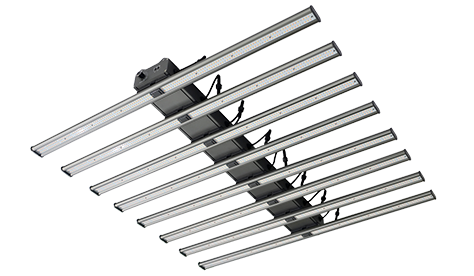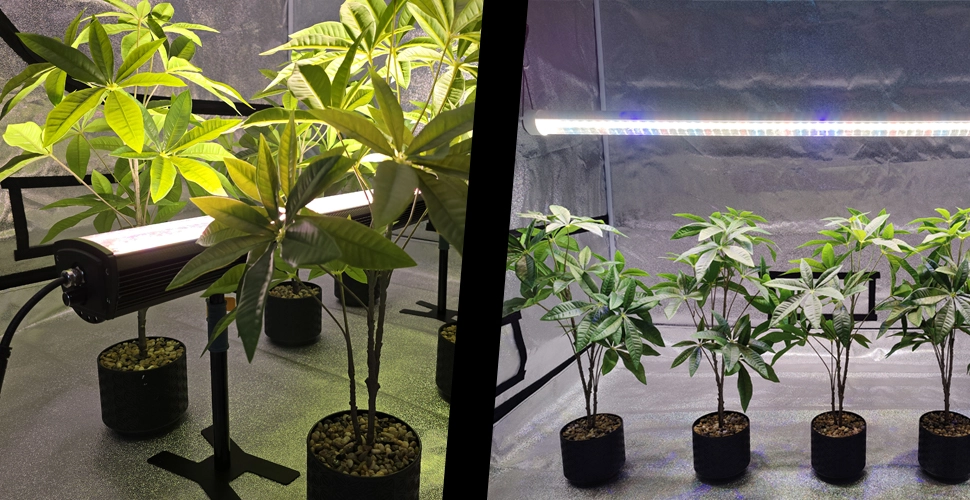Tabla de contenido
Hoy, luces de cultivo en interiores son una presencia esencial para el cultivo de plantas cubiertas, y las verá en todas partes.
¿Alguna vez has notado un fenómeno interesante? Las plantas crecen bien y saludables con luz natural que no parece tener ningún color, pero ¿por qué las luces de cultivo son moradas y algunas parecen blancas?
De hecho, las luces LED no son moradas, solo se ven púrpuras en nuestros ojos. Dado que las luces de cultivo interior emiten luz azul y roja de alta intensidad, que es una mezcla de longitudes de onda azul y roja en el espectro de color, este es el significado LED morado. Específicamente, las longitudes de onda azules de la luz son importantes para el crecimiento vegetativo, mientras que las longitudes de onda roja son importantes para la floración y la fructificación.
En este artículo, discutiremos las razones detrás de las luces Purple LED de cultivo y si vale la pena. ¡Vamos a sumergirnos!

¿Qué hace que las luces de cultivo de la planta sean moradas?
Las luces LED están compuestas por varias combinaciones de longitudes de onda que producirán la luz que proporciona para sus plantas. Pero hay más de una sola longitud de onda para cualquier conjunto de color dado. Los fabricantes de luz de crecimiento de las plantas determinarán longitudes de onda de color específicas que son beneficiosas para el crecimiento de las plantas Para crear luces de plantación LED. Su objetivo es crear una luz que sea beneficiosa para sus plantas de interior e tratar de evitar la luz que las plantas no necesitan.
Longitud de onda y color

Licenciado en DerechoLa longitud de onda de luz UE es de entre 430 y 500 nm.
Las longitudes de onda de luz roja están entre 625 y 740 nm.
Las longitudes de onda UV están entre 100 y 450 nm.
Hay tres tipos de longitudes de onda UV, dos de las cuales se utilizan en cámaras de crecimiento: UV-A y UV-B.
- UV-C: 100 a 290 nm.
- UV-B: 290 a 320 nm.
- UV-A: 320 a 400 nm.
Las longitudes de onda roja lejanas están entre 740 y 1050 nm.
El color púrpura emitido por las luces LED es una combinación de las longitudes de onda azul y roja de luz que componen la mayoría de los LED. La investigación ha demostrado que ambas longitudes de onda son críticas en el desarrollo de la planta, por eso Fabricantes de luz de cultivo LED Use múltiples longitudes de onda roja y azul en sus luces de cultivo.
Longitud de onda de luz azul
- Las longitudes de onda de luz azul promueven la salud de las plantas regulando el crecimiento.
El color azul de las luces de cultivo inhibe el alargamiento del tallo, y es beneficioso para las plantas que están enanas. Los tallos de las plantas de follaje expuestas a la luz azul son más cortas y las hojas de estas plantas son de color verde oscuro.
Por lo tanto, la luz en el rango azul también afectará el grosor de las hojas y el contenido de clorofila presente. Podrá producir plantas con hojas verdes más gruesas, más grandes y más oscuras dependiendo de las necesidades espectrales de la planta.
- La longitud de onda azul también afecta la coloración de la hoja.
Una planta de interior con hojas moradas como un bosque Pansy necesita radiación azul. De lo contrario, puede producir hojas verdes sin luz azul. Del mismo modo, las verduras de hoja verde como la col rizada y el brócoli producirán nutrientes más saludables con suficiente luz azul, obteniendo cantidades más adecuadas de nutrientes como vitaminas o antioxidantes.
- La luz azul controla la floración de las plantas.
La luz de alta intensidad de 20 μmol puede florecer plantas de día largo como espinacas, col rizada y apio. También puede inhibir el floración para plantas de día corto como crisantemos y clivia.
Longitud de onda de luz roja
- Las longitudes de onda de luz roja impulsan la fotosíntesis para un mejor crecimiento de las plantas.
En otras palabras, la luz roja tiene la mayor eficiencia para convertir la electricidad en fotones fotosintéticos. Esto se debe a que la luz roja generalmente es absorbida más fuertemente por los pigmentos verdes en las plantas.
Las plantas expuestas a más luz roja crecerán más altas. Puede usar la luz roja para promover o inhibir la extensión del vástago. También pueden producir hojas más delgadas y plantas más grandes y más altas.
Consejos: Debe ser consciente de que debe controlar la luz roja porque demasiado puede hacer que las plantas sean demasiado altas y delgadas.
- Es responsable de aumentar la tasa de fotosíntesis en las plantas.
La luz roja de las luces de cultivo púrpura también afecta la floración de las plantas, y es a través de una luz roja que las plantas obtienen la mayor energía.
Combinación de longitudes de onda de luz azul y roja
Individualmente, la luz azul ayuda a las plantas a crecer, mientras que la luz roja ayuda a la floración y la fotosíntesis. El amarillo y el verde absorben lo menos. Las plantas reflejan esta luz y, por lo tanto, son de color verde.
Sin embargo, los fabricantes de luz de crecimiento superior no hacen luces de planta que contienen todas las longitudes de onda durante el proceso de producción. Porque las plantas no absorben toda la luz por igual. Y elegirán el color de luz correcto y específico y aprovechará al máximo sus luces de cultivo de interior LED. Usa las luces correctas para ahorrar una gran cantidad de electricidad.
La combinación de longitudes de onda de luz azul y roja proporciona a sus plantas la luz necesaria para estimular todos los patrones de crecimiento simultáneamente, que es exactamente lo que sus plantas necesitan para prosperar.
Su combinación es importante, ya que permite que las plantas sigan los ritmos circadianos incluso en interiores. Permitir que las plantas casi sepan cuándo animarse y cuándo descansar, tal como lo hacen en la vida al aire libre.
Después de elegir las luces de cultivo correctas Para las plantas de interior, también debe prestar atención a la distancia que las coloca, el lugar correcto para colgarlos y cómo usarlos para maximizar la salida.
Consideraciones económicas

Las luces de cultivo púrpura no tienen sentido económico para los productores de hogares
Desde un punto de vista comercial, los chips LED rojo y azul son los más baratos de comprar. Los primeros fabricantes de luces de cultivo de plantas usarían esta combinación particular de espectros para formular cualquier receta de luz que quisieran. Debido a que los LED eran caros en ese momento, algunos fabricantes se centraron solo en proporcionar esas luces rojas y azules que eran absolutamente críticas para las plantas.
Pero en la última década, el costo de la tecnología LED ha caído, y el costo de fabricación y operación de estas luces ha disminuido drásticamente.
Hoy, una luz azul o roja típica de 10-30 W para las plantas cuesta menos de $ 20 por año por electricidad. En comparación con una luz vegetal de espectro completo de la misma potencia hoy en día, el ahorro de electricidad de una luz de planta púrpura es solo un dólar o dos menos por año que uno de espectro completo.
La diferencia en el ahorro de electricidad no es lo suficientemente grande como para hacer que la economía de las luces de cultivo de plantas moradas sea significativa para los productores de hogares.
Hoy, una luz de color púrpura interior de 10-30W de 10-30 W cuesta menos de $ 20 por año para la electricidad. En comparación con una luz de cultivo de espectro completo de la misma potencia hoy en día, el ahorro de electricidad de una luz de planta púrpura es solo un dólar o dos menos por año que uno de espectro completo. La diferencia en los costos de electricidad no es significativa. Por lo tanto, no creemos que la economía de las luces de cultivo de plantas moradas tenga sentido para los productores de hogares.
Pero si planea usar esta luz morada para plantas en todo el almacén y ejecutar operaciones agrícolas verticales, entonces puede ser de valor más significativo. Purple Light se beneficia mucho, pero dados sus otros inconvenientes, no creemos que esto sea tan importante como solía ser.

El espectro rojo y azul no es único
Gracias a los investigadores en este campo, el investigación Y la ciencia de cómo las plantas responden a la luz en los últimos 20 años han enriquecido nuestro conocimiento de la luz.
- UVA / UVB afecta los aceites, sabores y fragancias esenciales.
- La luz verde es muy buena en la penetración del dosel y la hoja, superando el rojo y el azul.
- El rojo lejano es un complemento particularmente bueno al azul, y ayuda a mejorar la expansión de las células vegetales.
Las luces de cultivo púrpura no son agradables
Existe un estándar de cuán cómoda o agradable es la luz para el ojo humano que llamamos el CRI, o el índice de renderizado de color. En pocas palabras, CRI determina cuán natural se ve el color de un objeto bajo diferentes tipos de iluminación.
Si la luz se ve extraña para el ojo humano, es demasiado aguda y no se ve natural, su valor CRI es bajo. Esto también puede significar que es simplemente una combinación de chips LED rojo y azul.
También aprendimos que las luces de cultivo púrpura emiten un espectro estrecho de luz, proporcionando a las plantas las longitudes de onda específicas de la luz que necesitan para crecer y prosperar. Aunque la luz roja o azul para las plantas es adecuada para la jardinería interior, su temperatura de color puede hacer que las personas sean menos cómodas por largos períodos de tiempo. Esto puede provocar fatiga visual o dolores de cabeza. Si también usa la luz de la planta púrpura, se recomienda que traiga sus gafas, incluso si son tonos solares muy ordinarios, durante el uso.
En contraste, la luz que se ve naturalmente agradable para el ojo humano tiene un alto valor CRI y puede estar compuesto por muchas combinaciones de colores diferentes de chips LED.
Resumir
Con suerte, a estas alturas, has encontrado la respuesta a ¿Por qué son luces de cultivo moradas? Y con suerte, este artículo responderá la pregunta de si vale la pena comprar una lámpara de planta púrpura.
Hoy, la mayoría de las luces de cultivo ya no son moradas. En nuestra opinión, una mejor opción es una luz de cultivo LED de espectro completo que garantizará una salud óptima de las plantas y un ambiente más cómodo.
Si vive en un área muy caliente y desea que el interior de su casa se sienta más fresco, busque luces clasificadas a 5000-5500K. La distribución espectral de estas luces se inclina hacia el azul y la temperatura de las luces de crecimiento será relativamente más fría.
Cuando vive en un clima más frío o tiene un espacio más pequeño, recomendamos una temperatura de luz más cálida en el 2700 – Rango de 3500k. Estos son rojos sesgados y tienen un brillo más cálido, posiblemente mejor para fructificar y florecer.
Si desea obtener más información sobre cómo encontrar la luz de cultivo de planta perfecta para sus plantas de interior, recomendamos ¿Son buenas las luces LED de espectro completo para las plantas??
jayes
Como gerente de marketing digital en AUXGROW, Jayes combina la pasión por los sistemas hidropónicos y la experiencia en luces de cultivo LED. Con experiencia práctica y un profundo conocimiento, Jayes le guía a través del mundo del cultivo sostenible.





